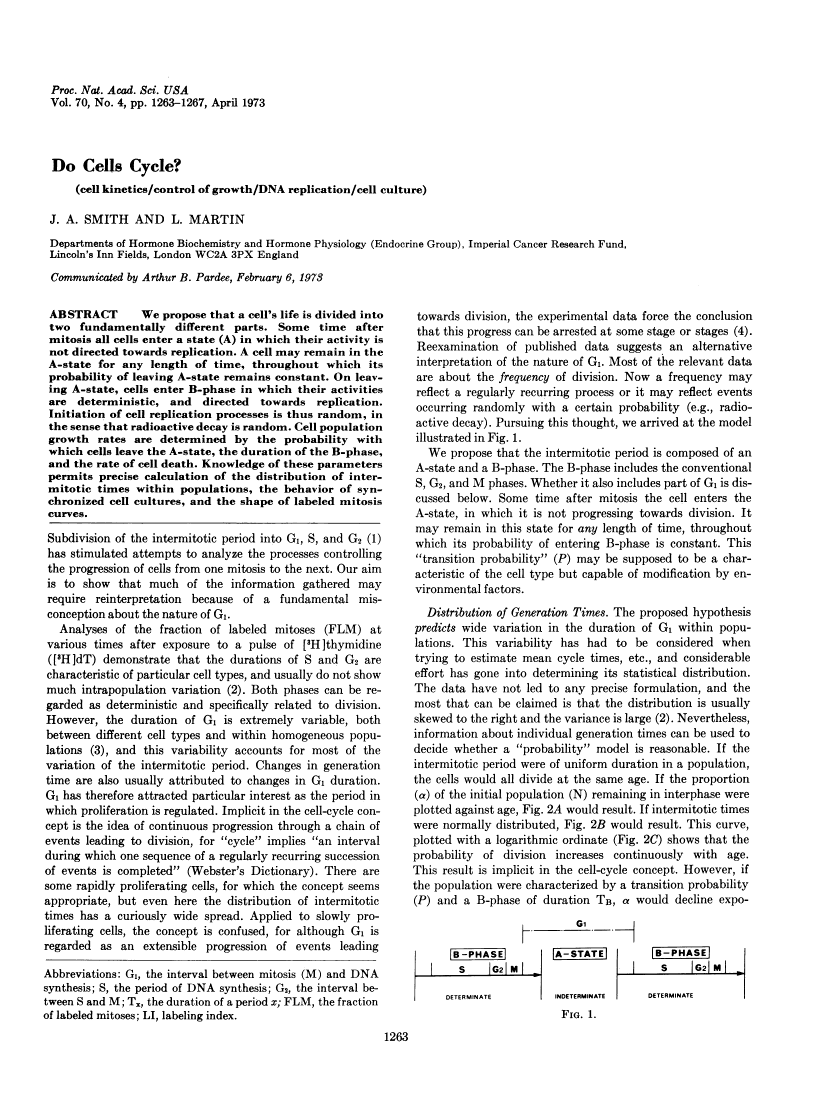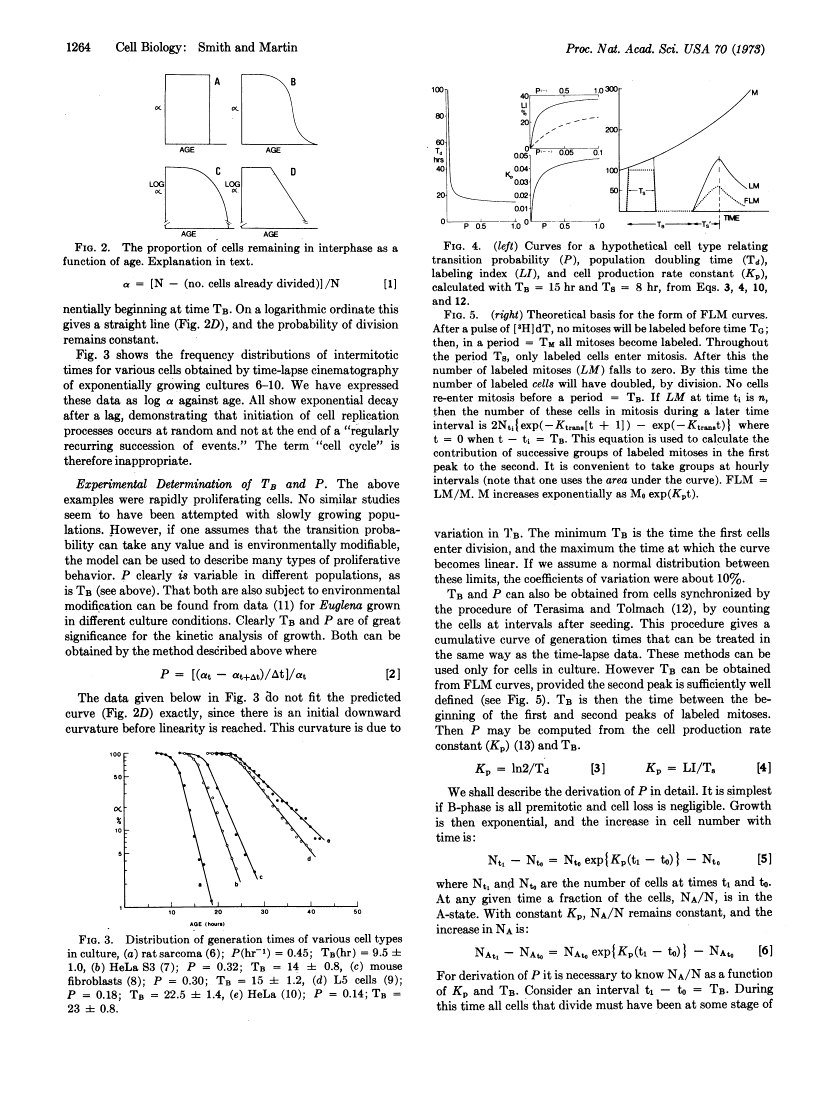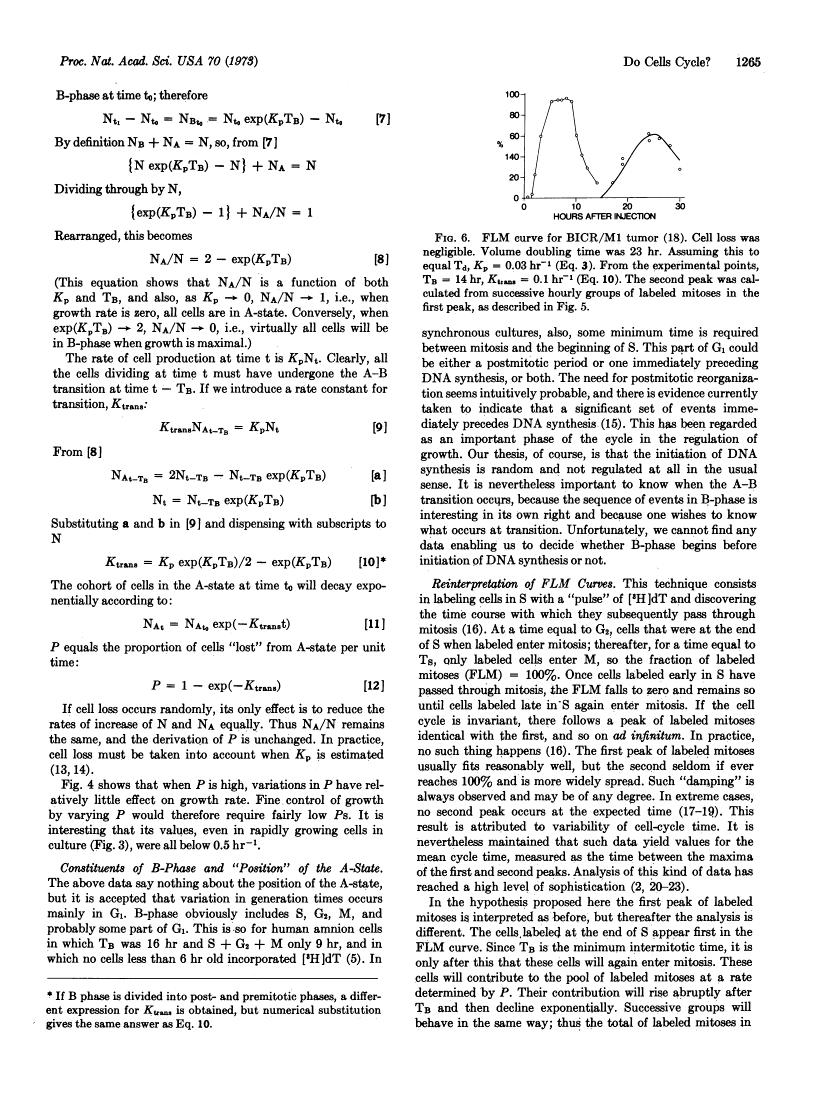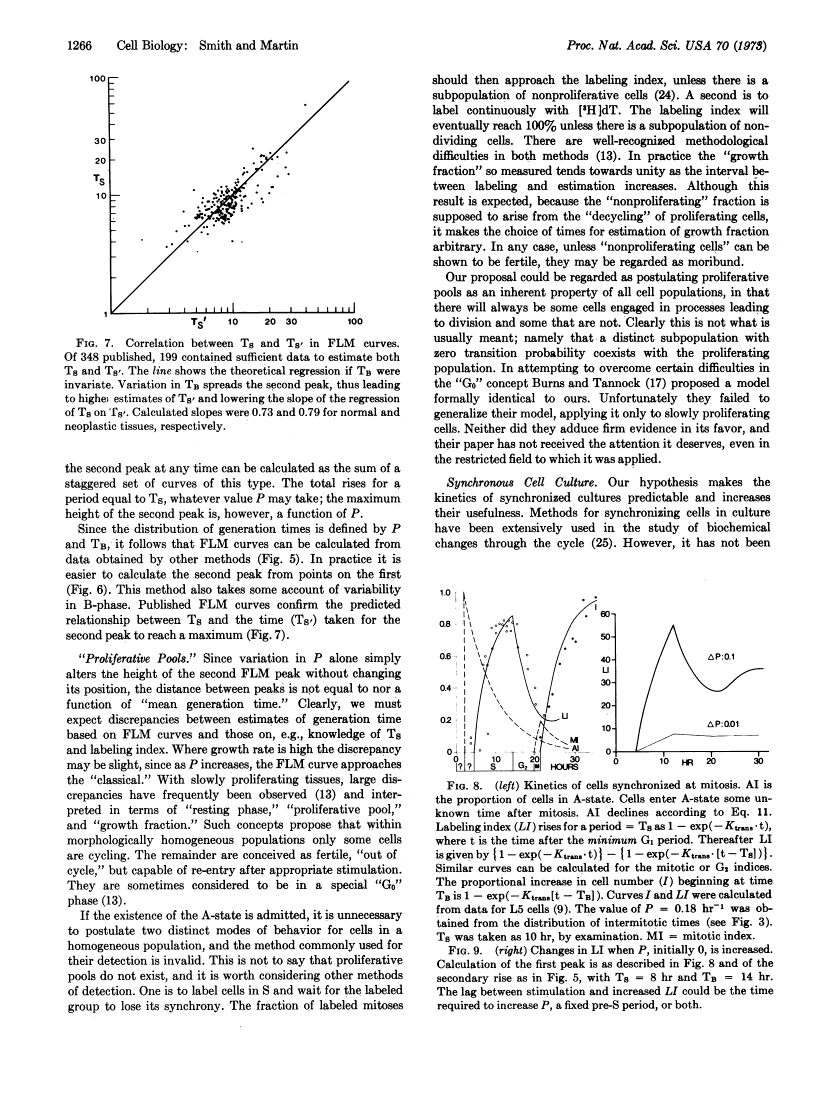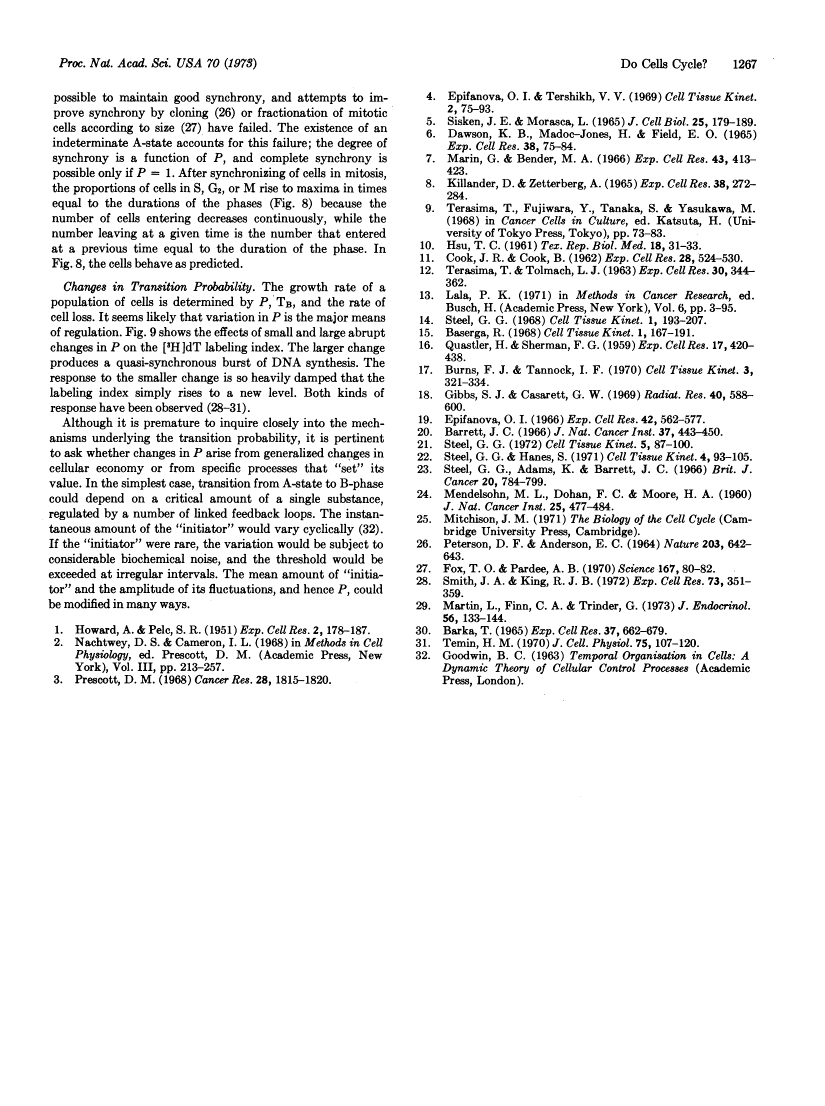Abstract
Free full text

Do Cells Cycle?
Abstract
We propose that a cell's life is divided into two fundamentally different parts. Some time after mitosis all cells enter a state (A) in which their activity is not directed towards replication. A cell may remain in the A-state for any lenght of time, throughout which its probability of leaving A-state remains constant. On leaving A-state, cells enter B-phase in which their activities are deterministic, and directed towards replication. Initiation of cell replication processes is thus random, in the sense that radioactive decay is random. Cell population growth rates are determined by the probability with which cells leave the A-state, the duration of the B-phase, and the rate of cell death. Knowledge of these parameters permits precise calculation of the distribution of intermitotic times within populations, the behavior of synchronized cell cultures, and the shape of labeled mitosis curves.
Full text
Full text is available as a scanned copy of the original print version. Get a printable copy (PDF file) of the complete article (939K), or click on a page image below to browse page by page. Links to PubMed are also available for Selected References.
Selected References
These references are in PubMed. This may not be the complete list of references from this article.
- Prescott DM. Regulation of cell reproduction. Cancer Res. 1968 Sep;28(9):1815–1820. [Abstract] [Google Scholar]
- LaBella FS, Sanwal M. Isolation of nerve endings from the posterior pituitary gland. Electron microscopy of fractions obtained by centrifugation. J Cell Biol. 1965 Jun;25(3 Suppl):179–193. [Europe PMC free article] [Abstract] [Google Scholar]
- Labella Frank S, Sanwal Madhu. ISOLATION OF NERVE ENDINGS FROM THE POSTERIOR PITUITARY GLAND : Electron Microscopy of Fractions Obtained by Centrifugation. J Cell Biol. 1965 Jun 1;25(3):179–193. [Europe PMC free article] [Abstract] [Google Scholar]
- DAWSON KB, MADOC-JONES H, FIELD EO. VARIATIONS IN THE GENERATION TIMES OF A STRAIN OF RAT SARCOMA CELLS IN CULTURE. Exp Cell Res. 1965 Apr;38:75–84. [Abstract] [Google Scholar]
- Marin G, Bender MA. Radiation-induced mammalian cell death: lapse-time cinemicrographic observations. Exp Cell Res. 1966 Sep;43(2):413–423. [Abstract] [Google Scholar]
- KILLANDER D, ZETTERBERG A. QUANTITATIVE CYTOCHEMICAL STUDIES ON INTERPHASE GROWTH. I. DETERMINATION OF DNA, RNA AND MASS CONTENT OF AGE DETERMINED MOUSE FIBROBLASTS IN VITRO AND OF INTERCELLULAR VARIATION IN GENERATION TIME. Exp Cell Res. 1965 May;38:272–284. [Abstract] [Google Scholar]
- HSU TC. Generation time of HeLa cells determined from cine records. Tex Rep Biol Med. 1960;18:31–33. [Abstract] [Google Scholar]
- COOK JR, COOK B. Effect of nutrients on the variation of individual generation times. Exp Cell Res. 1962 Dec;28:524–530. [Abstract] [Google Scholar]
- TERASIMA T, TOLMACH LJ. Growth and nucleic acid synthesis in synchronously dividing populations of HeLa cells. Exp Cell Res. 1963 Apr;30:344–362. [Abstract] [Google Scholar]
- QUASTLER H, SHERMAN FG. Cell population kinetics in the intestinal epithelium of the mouse. Exp Cell Res. 1959 Jun;17(3):420–438. [Abstract] [Google Scholar]
- Burns FJ, Tannock IF. On the existence of a G 0 -phase in the cell cycle. Cell Tissue Kinet. 1970 Oct;3(4):321–334. [Abstract] [Google Scholar]
- Gibbs SJ, Casarett GW. Influences of a circadian rhythm and mitotic delay from tritiated thymidine on cytokinetic studies in hamster cheek pouch epithelium. Radiat Res. 1969 Dec;40(3):588–600. [Abstract] [Google Scholar]
- Epifanova OI. Mitotic cycles in estrogen-treated mice: a radioautographic study. Exp Cell Res. 1966 Jun;42(3):562–577. [Abstract] [Google Scholar]
- Barrett JC. A mathematical model of the mitotic cycle and its application to the interpretation of percentage labeled mitoses data. J Natl Cancer Inst. 1966 Oct;37(4):443–450. [Abstract] [Google Scholar]
- Steel GG. The cell cycle in tumours: an examination of data gained by the technique of labelled mitoses. Cell Tissue Kinet. 1972 Jan;5(1):87–100. [Abstract] [Google Scholar]
- Steel GG, Hanes S. The technique of labelled mitoses: analysis by automatic curve-fitting. Cell Tissue Kinet. 1971 Jan;4(1):93–105. [Abstract] [Google Scholar]
- Steel GG, Adams K, Barrett JC. Analysis of the cell population kinetics of transplanted tumours of widely-differing growth rate. Br J Cancer. 1966 Dec;20(4):784–800. [Europe PMC free article] [Abstract] [Google Scholar]
- MENDELSOHN ML, DOHAN FC, Jr, MOORE HA., Jr Autoradiographic analysis of cell proliferation in spontaneous breast cancer of C3H mouse. I. Typical cell cycle and timing of DNA synthesis. J Natl Cancer Inst. 1960 Sep;25:477–484. [Abstract] [Google Scholar]
- PETERSEN DF, ANDERSON EC. QUANTITY PRODUCTION OF SYNCHRONIZED MAMMALIAN CELLS IN SUSPENSION CULTURE. Nature. 1964 Aug 8;203:642–643. [Abstract] [Google Scholar]
- Fox TO, Pardee AB. Animal cells: noncorrelation of length of G1 phase with size after mitosis. Science. 1970 Jan 2;167(3914):80–82. [Abstract] [Google Scholar]
- Smith JA, King RJ. Effects of steroids on growth of an androgen-dependent mouse mammary carcinoma in cell culture. Exp Cell Res. 1972 Aug;73(2):351–359. [Abstract] [Google Scholar]
- Martin L, Finn CA, Trinder G. Hypertrophy and hyperplasia in the mouse uterus after oestrogen treatment: an autoradiographic study. J Endocrinol. 1973 Jan;56(1):133–144. [Abstract] [Google Scholar]
- BARKA T. INDUCED CELL PROLIFERATION: THE EFFECT OF ISOPROTERENOL. Exp Cell Res. 1965 Mar;37:662–679. [Abstract] [Google Scholar]
- Temin HM. Control of multiplication of uninfected rat cells and rat cells converted by murine sarcoma virus. J Cell Physiol. 1970 Feb;75(1):107–119. [Abstract] [Google Scholar]
Associated Data
Articles from Proceedings of the National Academy of Sciences of the United States of America are provided here courtesy of National Academy of Sciences
Full text links
Read article at publisher's site: https://doi.org/10.1073/pnas.70.4.1263
Read article for free, from open access legal sources, via Unpaywall:
https://europepmc.org/articles/pmc433472?pdf=render
Citations & impact
Impact metrics
Article citations
Capturing the mechanosensitivity of cell proliferation in models of epithelium.
Proc Natl Acad Sci U S A, 121(45):e2308126121, 28 Oct 2024
Cited by: 1 article | PMID: 39467136
A comprehensive review of computational cell cycle models in guiding cancer treatment strategies.
NPJ Syst Biol Appl, 10(1):71, 05 Jul 2024
Cited by: 0 articles | PMID: 38969664 | PMCID: PMC11226463
Review Free full text in Europe PMC
High-volume, label-free imaging for quantifying single-cell dynamics in induced pluripotent stem cell colonies.
PLoS One, 19(2):e0298446, 20 Feb 2024
Cited by: 0 articles | PMID: 38377138 | PMCID: PMC10878516
Cell cycle plasticity underlies fractional resistance to palbociclib in ER+/HER2- breast tumor cells.
Proc Natl Acad Sci U S A, 121(7):e2309261121, 07 Feb 2024
Cited by: 4 articles | PMID: 38324568 | PMCID: PMC10873600
A mean-field description for the expansion kinetics of activated T cell populations.
Proc Natl Acad Sci U S A, 120(45):e2305774120, 01 Nov 2023
Cited by: 0 articles | PMID: 37910551 | PMCID: PMC10636355
Go to all (378) article citations
Other citations
Wikipedia
Similar Articles
To arrive at the top five similar articles we use a word-weighted algorithm to compare words from the Title and Abstract of each citation.
Mammalian cell cycles need two random transitions.
Cell, 19(2):493-504, 01 Feb 1980
Cited by: 113 articles | PMID: 7357616
Glucosamine incorporation during the mitotic cycle of primary chicken fibroblast cells.
Acta Biochim Biophys Acad Sci Hung, 9(1-2):53-61, 01 Jan 1974
Cited by: 3 articles | PMID: 4472124
INITIATION OF MITOSIS IN RELATION TO THE CELL CYCLE FOLLOWING FEEDING OF STARVED CHICKENS.
J Cell Biol, 21:169-174, 01 May 1964
Cited by: 35 articles | PMID: 14153479 | PMCID: PMC2106440
Role of cyclic nucleotides in cell growth and differentiation.
Physiol Rev, 56(4):652-708, 01 Oct 1976
Cited by: 170 articles | PMID: 185633
Review
